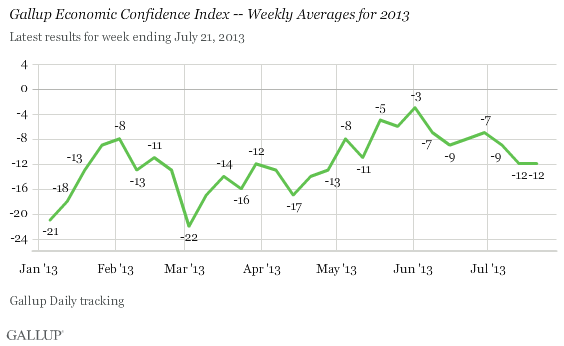WASHINGTON, D.C. -- Americans are less upbeat about the economy now than they were in May and June. Gallup's U.S. Economic Confidence Index held steady at -12 last week, but the current score is substantially lower than the five-year weekly high of -3 reached in late May and early June.

Americans' confidence in the economy has recovered from sharp drops this year during the "fiscal cliff" debate at the start of the year and the sequestration budget cuts that began in early March. The public's confidence inched closer to positive territory and reached a new peak in late May and early June after U.S. stock prices surged and housing values increased.
Still, consumer confidence is generally improved from levels Gallup has measured since 2008.
Gallup's Economic Confidence Index is based on Americans' ratings of current economic conditions in the U.S. and their assessments of whether the economy is getting better or worse. While Americans' assessments of both index components have worsened since late May and early June, most of the decline is from consumers' economic outlook.
For the most recent week, 43% of Americans say the economy is getting better and 52% say it is getting worse, for a net economic outlook score of -9. This score has sharply declined since it reached positive territory in late May and early June, but remains higher than the -24 reading in early March, the lowest score recorded this year.
Americans' assessments of current economic conditions this year have been steadier. Last week, 19% of Americans said the economy was "excellent" or "good," while 33% said it was "poor," for a net current conditions score of -14. This score is unchanged from the prior week and on par with the slightly lower scores that followed the early June reading of -9 -- the highest weekly score recorded this year.

Bottom Line
While U.S. stock prices have registered four consecutive weeks of gains, that has not been enough to maintain the higher levels of confidence Gallup measured in late May and early June. Higher gas prices, a struggling job market, and rising mortgage rates could be contributing to consumers' slightly lower levels of confidence in the economy.
Although Federal Reserve Chairman Ben Bernanke indicated last week that the economy is growing at a modest pace, he also cautioned that past and upcoming debates in Congress could negatively affect the economic recovery. If Congress engages in partisan bickering -- which Americans are mostly likely to mention as the reason they disapprove of Congress -- during negotiations over the 2014 federal budget and raising the debt ceiling, Americans' confidence could decline sharply, as it did recently during the fiscal cliff and sequestration debates.
Gallup.com reports results from these indexes in daily, weekly, and monthly averages and in Gallup.com stories. Complete trend data are always available to view and export in the following charts:
Daily: Employment, Economic Confidence, Job Creation, Consumer Spending
Weekly: Employment, Economic Confidence, Job Creation, Consumer Spending
Read more about Gallup's economic measures.
View our economic release schedule.
Survey Methods
Results for this Gallup poll are based on telephone interviews conducted July 15-21, 2013, on the Gallup Daily tracking survey, with a random sample of 3,045 adults, aged 18 and older, living in all 50 U.S. states and the District of Columbia.
For results based on the total sample of national adults, one can say with 95% confidence that the margin of sampling error is ±2 percentage points.
Interviews are conducted with respondents on landline telephones and cellular phones, with interviews conducted in Spanish for respondents who are primarily Spanish-speaking. Each sample of national adults includes a minimum quota of 50% cellphone respondents and 50% landline respondents, with additional minimum quotas by region. Landline and cell telephone numbers are selected using random-digit-dial methods. Landline respondents are chosen at random within each household on the basis of which member had the most recent birthday.
Samples are weighted to correct for unequal selection probability, nonresponse, and double coverage of landline and cell users in the two sampling frames. They are also weighted to match the national demographics of gender, age, race, Hispanic ethnicity, education, region, population density, and phone status (cellphone only/landline only/both, and cellphone mostly). Demographic weighting targets are based on the March 2012 Current Population Survey figures for the aged 18 and older U.S. population. Phone status targets are based on the July-December 2011 National Health Interview Survey. Population density targets are based on the 2010 census. All reported margins of sampling error include the computed design effects for weighting.
In addition to sampling error, question wording and practical difficulties in conducting surveys can introduce error or bias into the findings of public opinion polls.
For more details on Gallup's polling methodology, visit www.gallup.com.
